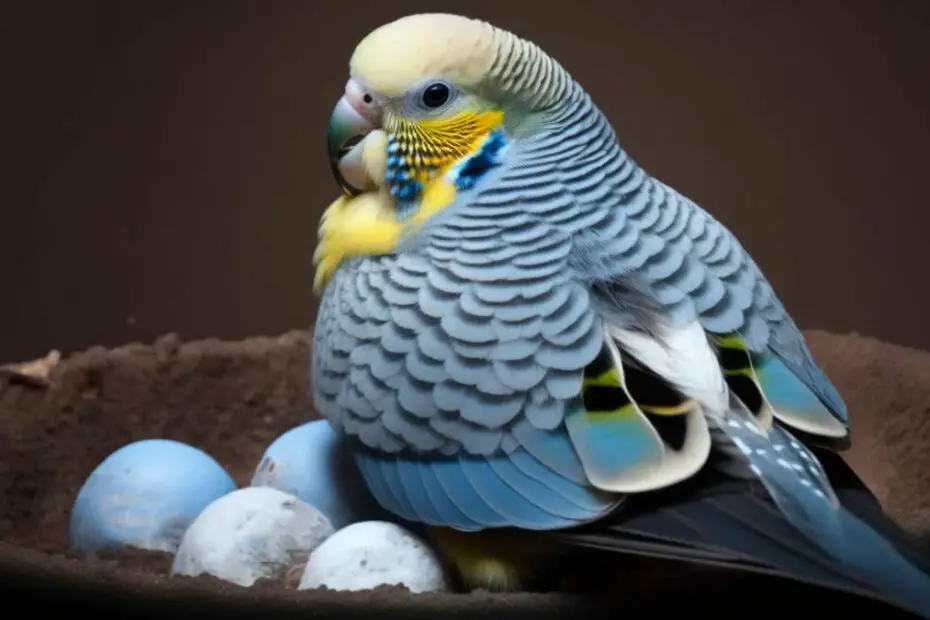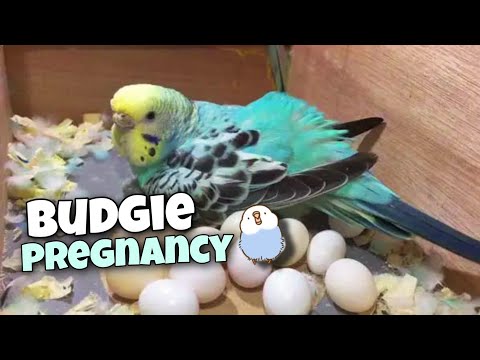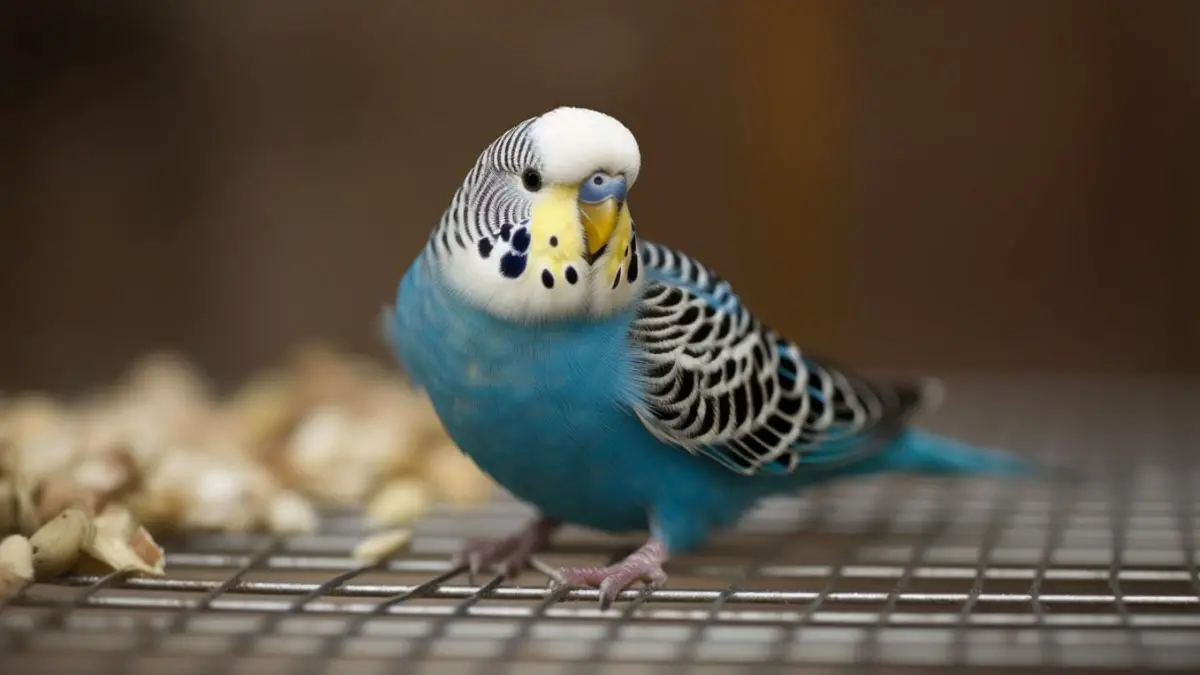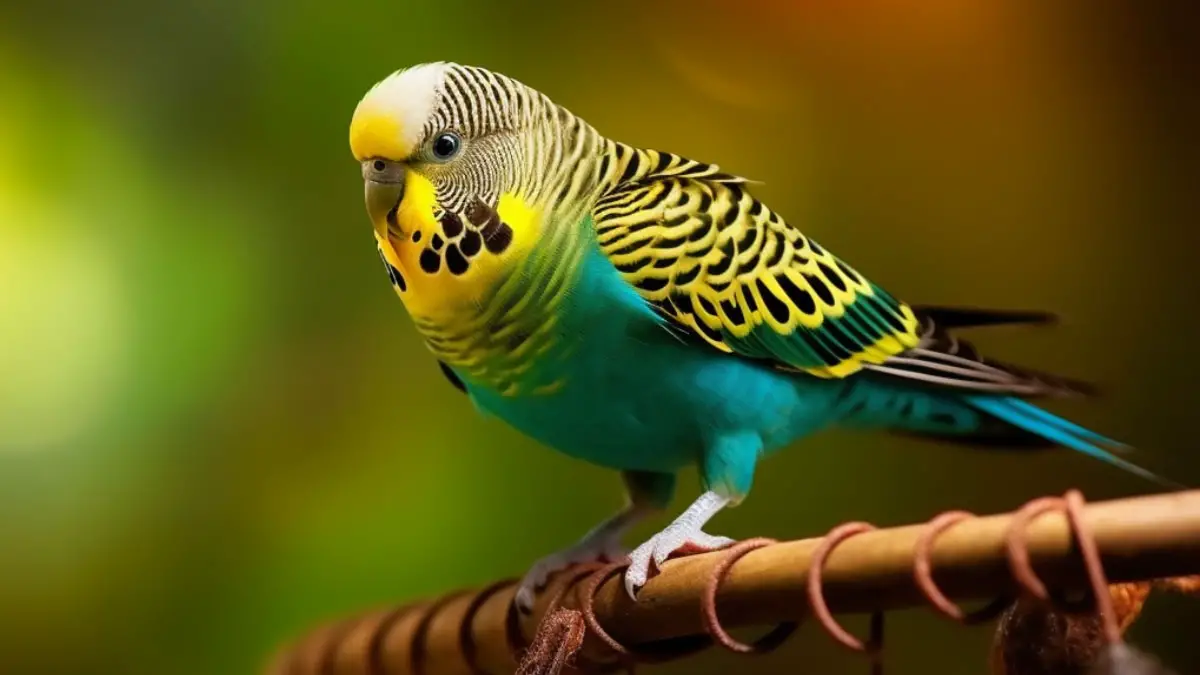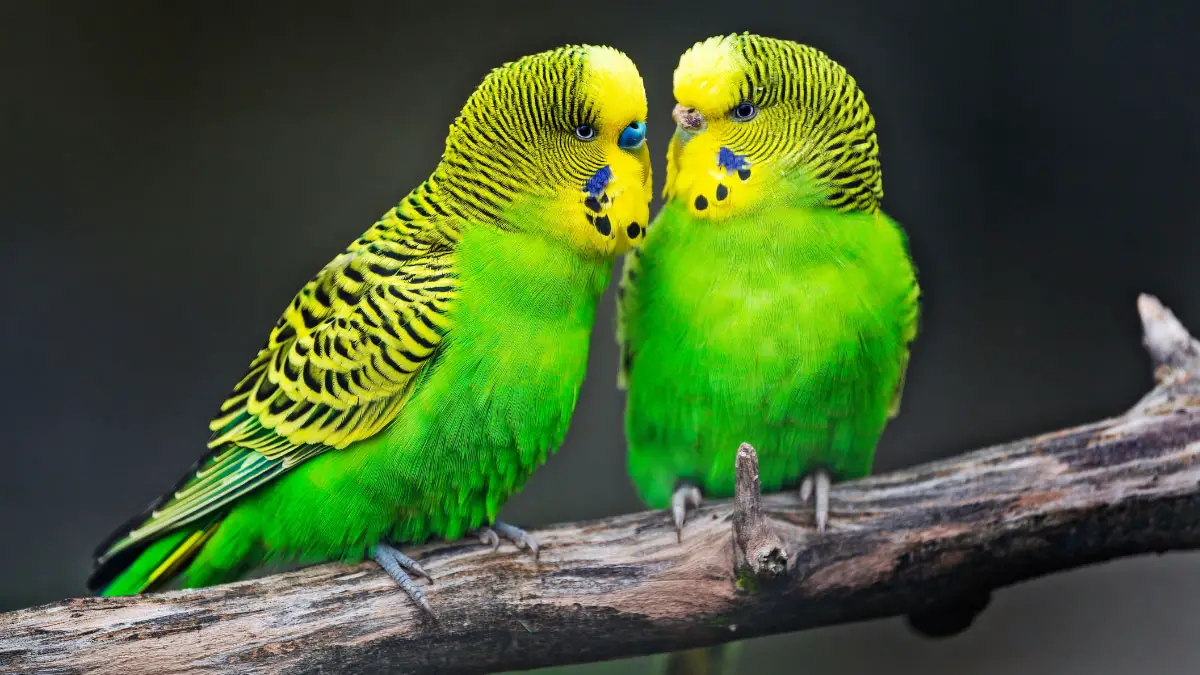First time breeding budgies? If yes, you may have countless questions running in your mind about what it is all like.
From wondering what the eggs look like to when you’ll see the first egg, how many eggs a budgerigar lays, how to know when your bird is about to drop ’em out, how to take care of the eggs—there’s so much to wonder!
In today’s post, we’ll do a budgie eggs 101 to enlighten you on every single fact you need to know about budge eggs.
We have gathered beginner budgie owners’ most commonly asked questions about the birds’ eggs, researched them, and compiled the best answers below.
Let’s get into the details right away…
How often do budgies lay eggs?
Budgies usually lay 2-3 times a year. These birds are all-year breeders and will lay eggs throughout the year if the environment is favorable for them, starting from the age of 5 months.
They lay their eggs in groups known as clutches, with each clutch containing around 4-8 eggs. They can go through 2 or 3 clutches yearly (and lay about 24 eggs annually).
After laying the first egg, the budgie will continue laying an egg every 1-2 days until she reaches the targeted clutch of 4-8 eggs.
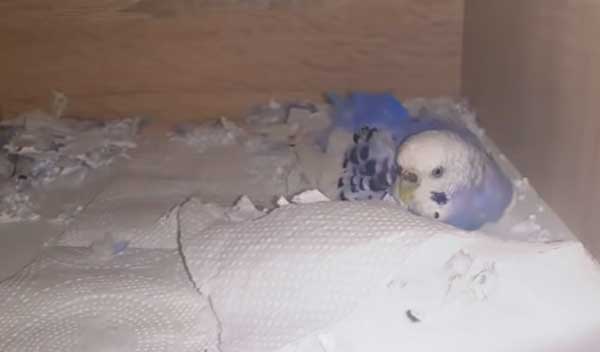
However, the egg-laying habits of budgies in captivity may differ from those in the wild.
A typical wild budgie tends to mate and breed depending on the season, temperature, and food abundance. They recognize when the weather changes from cold and short days to longer days full of warmth. This change represents a time of the year when the environment is favorable for them to raise their young ones.
When it comes to domesticated budgies, the temperature and length of days feel the same all year round since they’re always indoors. In other words, it’s always spring or summer for them. Not to forget you’re taking good care of them, and they have abundance of food all year long.
Combine all these factors, and your budgie pet has more favorable conditions for laying eggs all year round—enabling it to lay more eggs than its wild counterparts (i.e., 4-6 clutches vs. 2-3 clutches for wild birds).
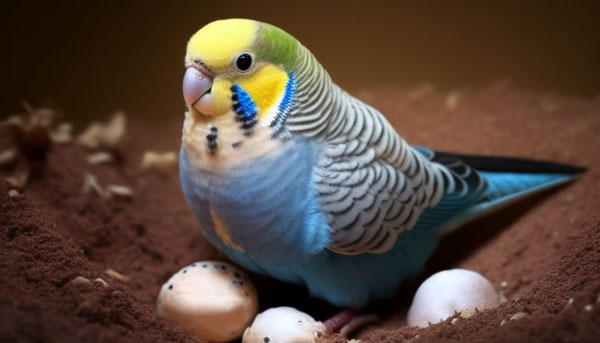
IMPORTANT: Though laying more eggs may sound like a good thing, it is not recommended for your female budgie to lay too many clutches of eggs in a short amount of time (chronic egg laying) as this can be harmful to its health.
Although any bird can develop chronic egg-laying, the budgerigars, alongside lovebirds and cockatiels, are more likely to do it. And this can lead to malnutrition due to the continued depletion of calcium from the hen’s body as it’s used in egg shell production.
It may lead to hypocalcemia if your budgie takes a calcium-deficient diet. In the long run, chronic egg laying can lead to egg binding, seizure, and sometimes death! (Source).
How many eggs do budgies lay?
Buddies tend to lay 4-8 eggs, dropping one after every 1-2 days until they hit their target clutch. However, it’s not unusual for these birds to lay less than 4 eggs or even surpass 8 eggs per clutch.
The explanation is that budgies are opportunistic breeders and can lay any number of eggs provided the atmosphere favors their breeding process.
If this is the first time your female parakeet is laying eggs out of perch, she might not know where to lay them and even how to take care of them. You may find the eggs laid on the floor of the cage if you have not provided it with a good nesting area in its cage.
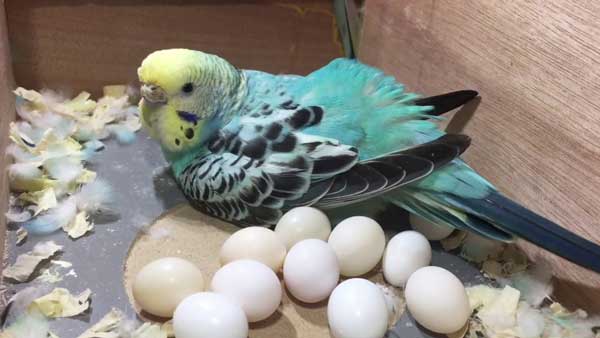
In an unfortunate incident, the egg may hit the cage floor or grate and get broken, rendering it useless.
However, you can guide your budgie on where to lay her eggs by placing the laid eggs in a nest/egg box. This way, she’ll see them and get an idea of where to drop them the next time.
What do budgie eggs look like?
It is pretty easy to identify budgie eggs. You should expect them to be small, given that budgies are small creatures.
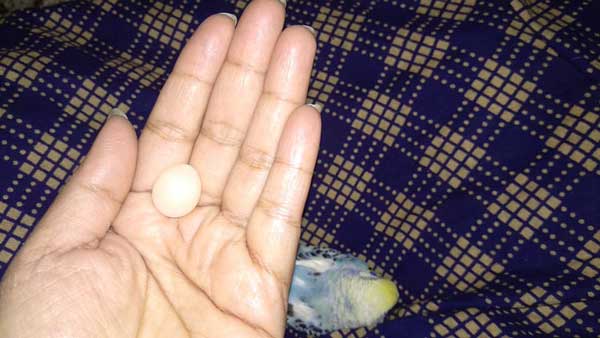
Here’s a description of what the budgerigar eggs look like:
- Size: The average size of budgie eggs is 1-2cm (0.4-0.8 ″) wide and 2-3cm (0.8-1.8 ″) long
- Shape: The eggs are usually oval and wide in one end, but some may come out in a circular form. Don’t start panicking when the eggs from your budge don’t appear identical. They may come out in either shape from the same budgie.
- Color: Healthy budgie eggs can be off-white, white, or slightly grey.
How long is a budgie pregnant before laying eggs?
A female budgie starts laying eggs 8 to 10 days after bonding and mating with the male. After this period, you’ll notice your budgie starts spending most of its time in her cage.
You’ll also notice her start looking for food rich in calcium. This is because the mineral is vital for healthy egg production.
When she’s closer to laying her first egg, the hen will spend almost all her time inside the nest, including night time. It has also cleaned its nesting area by removing unwanted sticks and materials.
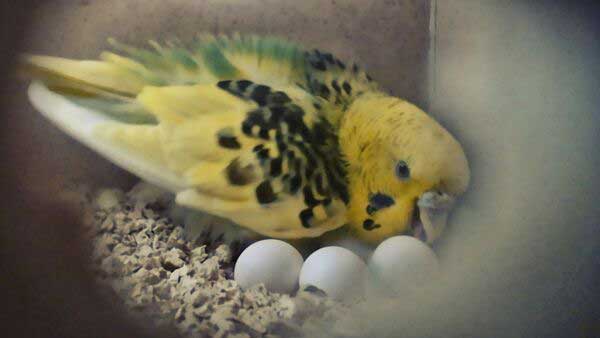
You should also take note of the signs we discussed earlier of a budgie about to lay eggs to help you make all the necessary preparations in advance.
Once she produces her first egg, you should expect your female budge to produce another egg every 1-2 days until she reaches her targeted clutch.
Can Female Budgies Lay Eggs Without a Male?
Yes, female budgies can lay eggs without a male. But such eggs will stay unfertilized and cannot hatch into chicks. This usually happens when you keep a female budgie alone or with other female budgies, with no male present.
Naturally, all female budgies can lay eggs every now and then, even before they mate with a male budgie.
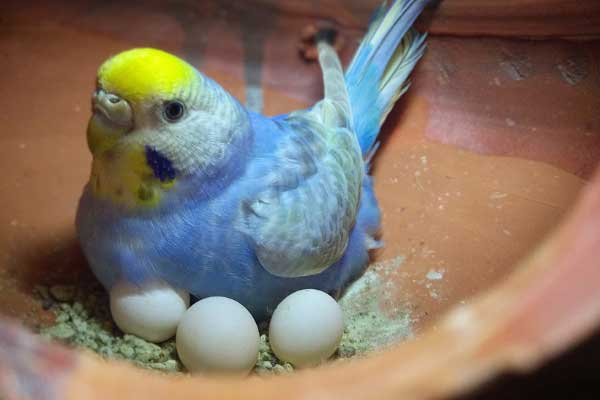
Various external factors influence budgies to start the egg production process.
For instance, exposure to sunlight tells the budgie that spring has arrived, and food and water will be in plenty. This translates to favorable weather for raising her chicks.
At some point, the bird’s body will undergo hormonal changes that prepare its body for reproduction. She’ll then start looking for a male. But if she doesn’t find one, she’ll go ahead and lay unfertilized eggs as they have already formed in readiness to be laid.
Unlike egg-laying mammals, budgies cannot retain the male sperm from a previous breeding season. This means copulation must occur when the eggs are developing inside the female to be fertilized.
If the eggs aren’t fertilized, they won’t be reabsorbed into the female budgie, but she’ll still lay them.
Young budgies new to motherhood and mating tend to sit on these unfertilized eggs to try and incubate them. Unfortunately, they’re unviable and won’t hatch into chicks; they end up rotting and must be thrown away by either you or the bird.
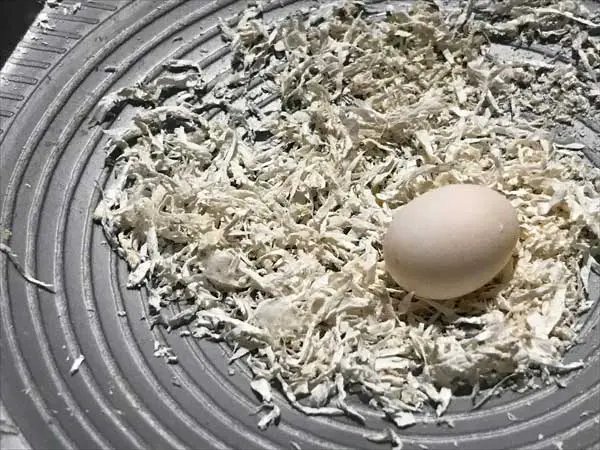
Sometimes a budgie may produce unfertilized eggs even after she’s coupled with a male. This especially happens for young females lacking mating experience, and the sperm fails to reach or fertilize the eggs.
What to do with unfertilized budgie eggs?
More experienced budgies usually take a few days to tell apart unviable eggs. They will even push them out of the nest on their own.
You can also take it upon yourself to dispose of the eggs. But be careful how you go about it. You can dispose of them immediately after they’re laid if the budgie chooses to ignore them and doesn’t get distressed.
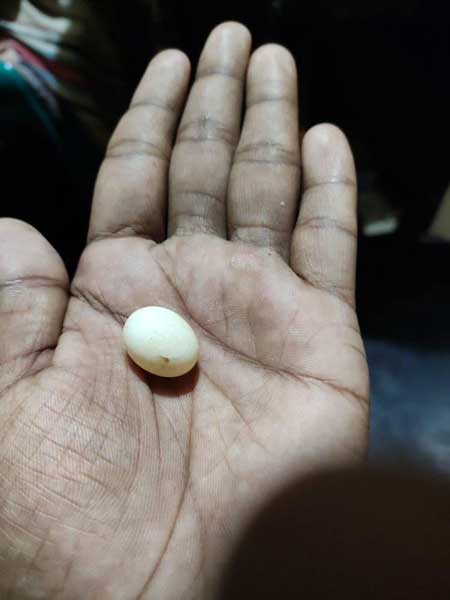
If she chooses to nest and brood over the eggs, taking them away van be distressing to your budgie. She may even become aggressive when you try to take them or turn frantic after you’ve taken them.
Just wait for the parakeet to lose interest in nesting the eggs or let it realize on its own that they’re infertile. You can now throw them away at this point without unsettling your budgie.
Budgie Egg Laying Signs
When your budgie is about to lay eggs, she may undergo some physical transformation in readiness to lay eggs. She may also adopt some new behaviors that further indicate gravidness
Below are some of the tell-tale signs of a budgie that’s about to lay eggs:
Dropping bigger poop
When the budgie eggs are being produced in its body, they occupy some significant space, leading to reduced torso. This results in the bird not pooping as often as before.
As the egg development continues, the poop becomes much larger. And it gets even bigger as the eggs near the coca and the female is almost due to start laying them.
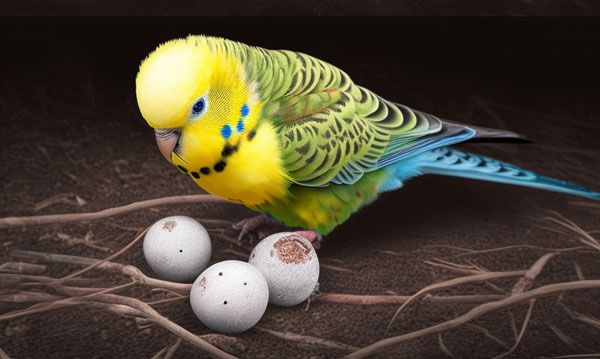
However, note that it’s not easy to tell when the female starts dropping this bigger poop unless you make a closer observation. These birds are known to poop a lot; they tend to relieve themselves after every 10-15 minutes.
Also, reduced popping may also be a sign of a sick budge. So it doesn’t always mean the bird is about to lay eggs.
Look for the egg bum
Another way to tell whether your budge is about to lay eggs is by inspecting her vent. Simply pick her up and gently feel the vent area. If you feel a soft but solid bump, that’s an egg bum and indicates the bird is gravid!
The egg bum shows up because these birds have small bodies and lack a lot of internal space for carrying the eggs. As a result, the eggs about to be laid are usually pushed against the vent—making it a strong indicator of a pregnant budgie!
Keep in mind, though, that budgies usually carry 4-8 eggs. And if your pet has less than this number or is larger for her breed, it might be hard to tell if she’s about to lay eggs using this method.
Notice change in cele color
Female budgie celes are usually light-blue or white in color. However, the cele tends to change color to off-white or brown when the birds near their breeding season. It may also become thicker and crustier.
If you notice this transformation in your female’s cele, alongside the bird pooping less and getting more defensive, it may be a sign that she’s gravid!
Additional signs to look out for:
While these additional signs aren’t always a true indicator that the bird is about to lay eggs, they may point towards that possibility. We suggest pairing them with the main signs above. If they match up, the chances are that your bird will soon lay eggs.
- Weight gain: your budgie adding a few extra grams to her body may mean she’s about to lay eggs. However, this isn’t quite a tell-tale sign as most folks aren’t able to weigh this bird successfully!
- A swollen abdomen: As we have said earlier, budges have small body systems. Thus, another way their sign of carrying eggs may manifest is their abdomen swelling up slightly to accommodate the eggs they’re about to drop. However, this sign may be difficult to notice, given that feathers can change the bird’s torso.
- Brood patch: This is a small featherless patch of skin birds develop around their vent during the period. It is an indicator that your budgie is about to mate. So, if you can’t tell whether it is gravid, you can use this patch to know whether it will happen soon.
- Budgie gets more defensive: A budgie’s estrogen hormone levs increase when she’s about to produce eggs. This hormone level alteration makes her act more defensive of herself, her nesting area, and even her mate. The budgie fighting and biting you is a sign of being protective.
- The bird becomes more affectionate: When the budgies want to mate, you’ll notice them becoming more affectionate and flirty with each other. They usually display this affection by spending most of their time side by side, regurgitating into the mouth of each other, display of their colorful fathers, courting by strutting, and so on.
- She spends more time in her nest: If you notice your budgie spending more time around her nest, she may be gravid. Budgies that are ready to mate usually become obsessed with their nests. Look for additional signs like the budge feathering her nest, defending the area from other budgies, and sitting inside the nest instead of playing or socializing around it.
IMPORTANT: Don’t confuse pregnancy for sickness! Some of the changes in your bird’s behavior and body discussed above may not also be a sign that she’s sick. As the Veterinary Nursing Journal explains, budgies hide their sickness quite well. Hence, you need a keen sense of observation to tell if your bird is carrying eggs or is sick.
How to Candle Budgie Eggs To Check Fertility
Remember what we said earlier? Budgies can lay unfertilized eggs if you keep them away from the males. Needless to say, these eggs do not hatch into chicks.
The good news is that candling can easily check whether your budgie eggs are fertilized or unfertilized.
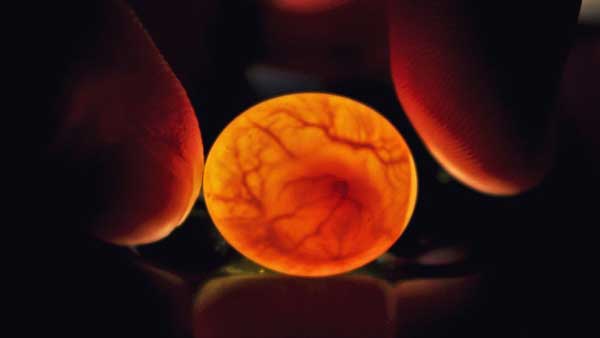
This is how you do it:
Hold a light source, e.g., your phone light, up to the budge egg you want to check until it becomes illuminated and you can see through. If there’s a developing embryo inside, you should be able to see it. For successful candling, consider conducting this exercise in a dark room.
Besides a developing embryo, you should also look for a network of blood vessels. However, you’d want to use a bright flashlight to see them. Otherwise, the blood vessels might be a bit difficult to know if using a light source that’s not powerful enough.
Carry out candling method only if you have young birds or if you find that budge has pushed out an egg from its nest. Otherwise, you’d want to avoid mishandling the eggs and leave them alone.
You can candle the eggs without necessarily touching or moving them from the egg box. You just need to be able to have a good look at them as they rest in the nest. But if this is impossible, simply hold the egg between your thumb and finder while wearing gloves.
Still, this method of checking egg fertility will not work for newly laid eggs as they’re hard to parse. Wait until the egg is around 7-8 days old to tell if it’s viable.
Budgie egg hatching chart:
Keeping track of your budgie’s egg hatching can be confusing for beginner and experienced budgie owners. But with this 18-day egg chart, you can easily tell when you should see your budgie’s first chick.
To use this chart is pretty simple. Just take note of the day the egg was hatched on the chart. The number sitting directly below it (on the next line) becomes the expected hatching date for the egg.
18-Day Egg Chart:
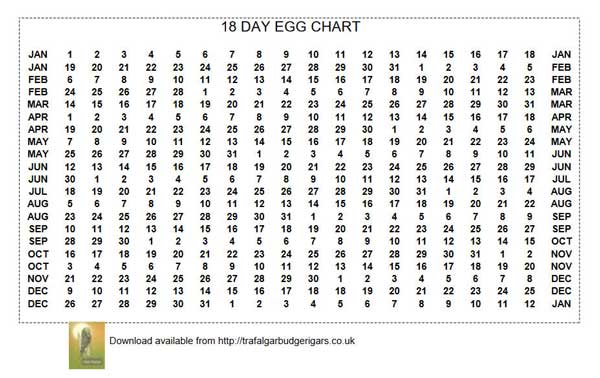
How long do budgie eggs take to hatch?
Budge eggs take 18 days to hatch from when the hen incubates them. Note that the budge will not start lying on her eggs until she has laid her second or third egg.
After the 18 days are over, the chicks will start hatching. But they can take up to 2 days to be completely free from the eggshell.
We advise you against the temptation to help release the chick from the eggshell. This is a common mistake for beginner budgie breeders, but it’s unwise to interfere with the process. Just let nature takes its natural course!
Any unhatched eggs after being incubated by the budge for up to 23 days have zero chance of producing a chick. You should consider throwing them away.
It is impossible to tell if a budgie will hatch all her eggs. Not even the professional breeders can tell. In worst cases, only one out of all the eggs may hatch.
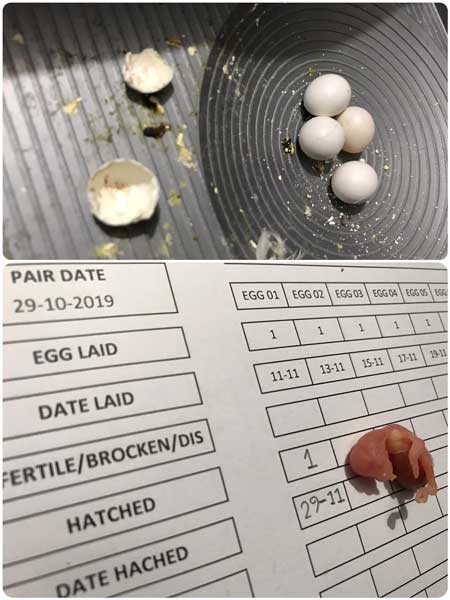
For this reason, you shouldn’t have any expectations, or they may get disappointed (play by the old adage—don’t count your chicks before they’re hatched.
It is normal for budgie eggs to fail to hatch after a successful incubation period.
There are several reasons behind this. For instance, there could be reproduction issues with the male or female, hen negligence on the eggs, eggs failing to get fertilized during mating, problems occurring during the incubation period, etc.
How to incubate budgie eggs at home?
You can incubate budgie eggs at home using an incubator machine with temperature and humidity controls. The role of incubating budgie eggs usually falls to the female budge. But if it’s unavailable or can’t incubate them, you can take up the task and do artificial incubation.
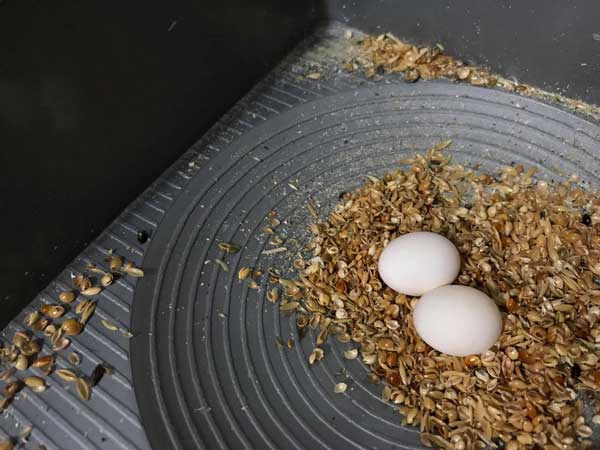
For the eggs to hatch successfully, you need to incubate them for up to 18 days. Below are the exact steps to follow to incubate budgie eggs at home:
Step 1. Get the right incubator machine
Your first need to get a quality incubator that helps you maintain the ideal incubation temperature and humidity for the budgie eggs.
If your budget allows, you can use more advanced units that feature microprocessor controls for regulating heat, humidity, and cooling.
The best machine should also feature a self-tuning system that makes it hassle-free to ensure no side of your eggs receives more heat than the others.
Step 2. Setting your incubator temperature
When you finally get your hands on an ideal incubator, it’s time to set it up for use. Start by setting the correct temperature for incubating the bird eggs. This should be around 98.7-99.1 degrees Fahrenheit.
Note that it’s important to maintain this temperature range for successful hatching. If the eggs overheat, they may fail to hatch. Or the resulting chick will be weak.
Likewise, temperatures falling below the optimal range will cause the eggs to hatch late. Low temperatures will also affect humidity levels. And the embryo may be unable to absorb its yolk sac, greatly minimizing its survival chances.
TIP: Though most incubators come with a built-in thermometer, we still advise you to double-check the temperature using a reliable electronic thermometer or glass-stem thermometer.
Step 3. Setting your incubator humidity
Next, you’ll need to set the perfect humidity levels inside the incubator. This should be 65% ± 5% for the budge eggs. Similar to temperature, humidity is also vital for incubating budgie eggs.
Humidity control allows for balancing out natural evaporation of the fluid from within eggs as the chick grows, increasing airspace inside the egg.
Step 4. You must turn the eggs regularly
Lastly, the eggs inside the incubator must be turned regularly for successful incubation. Ideally, you should turn the eggs about 4-8 times every day or once every hour.
This step is necessary as it promotes the growth of veins and the development of blood vessels in the early stages of embryo development (i.e., up to around 10 days).
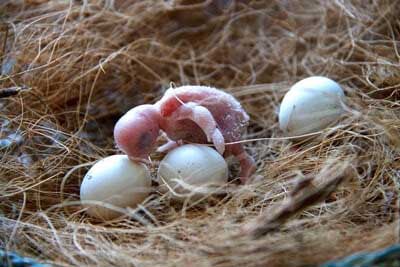
Continued turning of the eggs as the embryo develops helps prevent malformation and ensure even growth. Turning eggs should become less of concern only after the eggs have undergone full vein growth.
TIP: Get an incubator with turning function specially made for budgie eggs. This ensures the eggs are turned at set intervals, increasing the chances of hatching healthy chicks.
BONUS Step: Alternatives to an incubator
What if you don’t have a budget for an incubator machine? In that case, you can use other effective methods to incubate budge eggs at home. These include:
Use a substitute mother
Get a female budgie to incubate the fertile budgie eggs. Simply place the eggs underneath or near the substitute mother nesting area. The parakeet will roll the eggs in her nest and put them under her body.
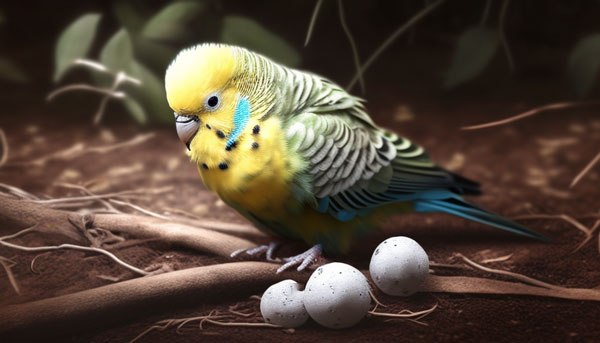
The new mother will adopt the hatchlings after they come out. The new mother might reject the eggs for her own reasons or for the same reason the other female rejected them.
Use a towel
This method involves incubating the eggs manually using household items. Place your budgie eggs on a clean medium-sized towel (the towel should be inside a cardboard box) and fold it around the edges.
Place a desk lamp powered by a 40-watt bulb next to the box and ensure it (the bulb) faces toward the center of the towel.
Let the lamp shine on the eggs for 12-16 hours each day. Remember to roll the eggs about 4-8 times daily or once every hour.
Can you touch a budgies egg?
Don’t touch your budgies egg unless it’s absolutely necessary. You may only need to touch them when checking for fertility or when you need to move them. Even then, make sure you wear clean gloves.
Also, be gentle on the eggs or avoid putting extra stress on them or accidentally breaking them and damaging them.
If you notice your budgie ejecting an egg from its nest, there’s highly likely it has a reason for doing so. It might have removed them as it views them as undesired intruders in her nest.
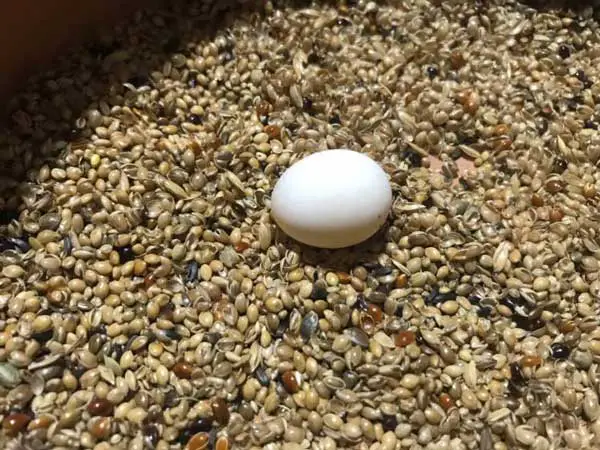
Or it could be that the eggs are damaged or infertile. Or you could have touched them, and the bird can detect that they don’t smell like her own.
Budgies are generally good parents, provided they have a suitable environment for nesting and breeding. And you don’t need to worry about taking care of their eggs. As much as possible, avoid handling the eggs. Unless you must do it!
How do I stop my budgie from laying eggs?
If your budgie is laying too many eggs a year (remember we said earlier that this chronic egg laying can harm its health), you may wonder if there’s anything you can do to stop it and save its health.
Generally, you can stop your budgie from laying eggs for good. However, you can take some preventive measures below to discourage this egg-laying behavior.
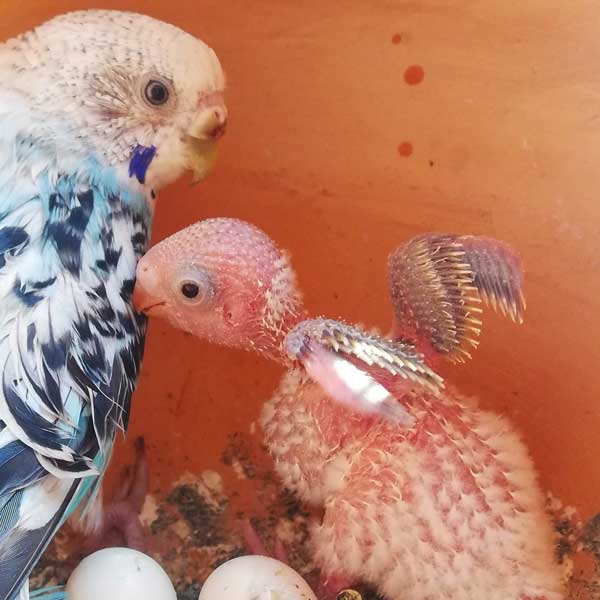
- Keep the female budgies separated from the males as much as possible. if you must, keep them in separate cages
- Make a habit of frequently changing her cage location and the items within the cage. This is especially helpful as spring draws closer.
- Avoid providing your female budgie with nest materials or eggs box to discourage favorable laying conditions
- Limit your birds’ exposure to daylight. This is helpful because seeing longer days tend to shift these birds into mating behavior
- Make sure the room your birds live in stays cool to trick them into thinking it’s not yet spring
- Lastly, avoid petting your female budgies below their necks. Unknown to most budgie owners, this can trigger mating behavior in the birds.
Do budgies eat their own eggs?
Yes, budgies can eat their own eggs sometimes. As you continue with the fun journey of petting your budgies, you may occasionally catch them breaking the eggs, whether accidentally or intentionally, and eating the egg shell and yolk afterward.
There are many reasons why a budgie might eat its own eggs. The most common cause is calcium deficiency in the diet. Improving the bird’s diet to get enough calcium will help prevent this bad habit.
Another reason your budgie may eat its own eggs is due to anxiety or fear caused by the presence of predatory animals, which can cause the birds to eat their eggs. The bird may get scared of people and other pets like dogs and cats and view them as predators that can attack them anytime. This will make them get rid of the eggs before the predator takes over.
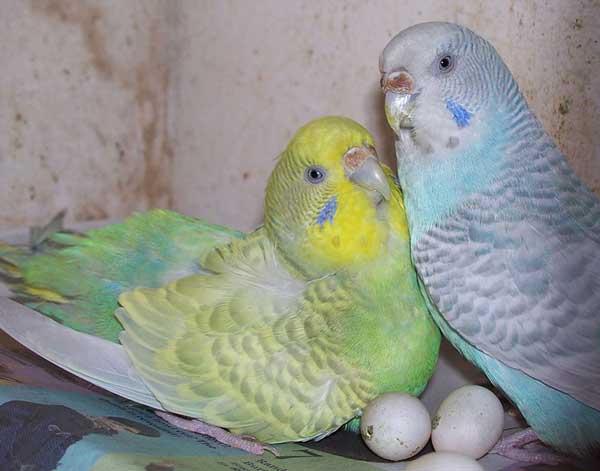
Overcrowding in their cage. Too many budgies in the same cage will cause the female to feel uncomfortable and tensed, making her resort to weird habits like eating her own eggs. Don’t put too many budgerigars in the same cage. If you must put them together, get a big, spacious cage where the birds can freely move around.
If one of her hatchlings gets sick or comes out deformed, the budgie may kill and eat it to nourish its proteins or simply get rid of it and prevent the rest of the chicks from getting sick.
Lack of enough food or competing for the same during the breeding period may also make the budgie eat her eggs. Ensure you feed your bird the right diet during breeding to ensure it doesn’t eat her eggs. You may even consider consulting your vet for a custom diet plan for the soon-to-be mommy budgie.
New, inexperienced mothers and poorly socialized budgies may also eat their eggs.
Luckily, a budgie eating its own eggs doesn’t affect its health. In fact, it will help them get the nutrients in the diet you feed them. Nonetheless, you shouldn’t encourage this behavior in your parakeet. You should take the necessary measures to stop it from happening again.
Final Words
That’s it for our budgie eggs 101 guide! We have just covered nearly all the facts you need to know about budgie eggs, whether you’re planning to get your first pair of budgies or you’re the newest budgie owner on the block.
You should now be able to tell when your female budgie is pregnant, when she’ll lay her first egg, and how often she’ll lay eggs. You also know how to handle the eggs with care, how to check them for fertility, how long it takes the bird to hatch eggs, how to incubate them at home, and other important facts.
We hope that this guide has been informative about budgerigar eggs and you’re now more enlightened about the breeding behaviors of these cute little birds.
